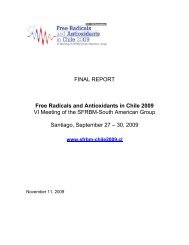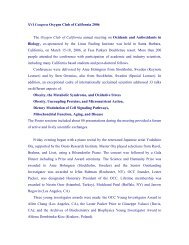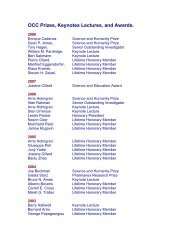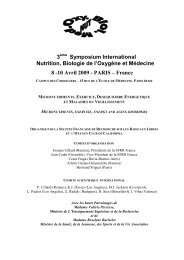oxidants and antioxidants in biology - Oxygen Club of California
oxidants and antioxidants in biology - Oxygen Club of California
oxidants and antioxidants in biology - Oxygen Club of California
You also want an ePaper? Increase the reach of your titles
YUMPU automatically turns print PDFs into web optimized ePapers that Google loves.
Free radicals produced <strong>in</strong> exhaustive exercise as signals <strong>in</strong> muscle<br />
cell function. Role <strong>of</strong> xanth<strong>in</strong>e oxidase<br />
GÓMEZ-CABRERA MC, GARCÍA-DEL-MORAL L, ROYO D, LLORET<br />
A, RUS D, BORRÁS C, PEREDA J, SASTRE J, PALLARDÓ FV, VIÑA J<br />
Department <strong>of</strong> Physiology. Faculty <strong>of</strong> Medic<strong>in</strong>e. University <strong>of</strong> Valencia.<br />
Exercise produces free radicals (1). We found that free radicals<br />
are produced only when exercise is exhaustive (2,3). Recently, we<br />
postulated that xanth<strong>in</strong>e oxidase is <strong>in</strong>volved <strong>in</strong> oxidant production<br />
<strong>in</strong> exercise <strong>and</strong> showed that allopur<strong>in</strong>ol, an <strong>in</strong>hibitor <strong>of</strong> this enzyme,<br />
prevents damage associated to exhaustion <strong>in</strong> animals (4).<br />
Dur<strong>in</strong>g the Tour <strong>of</strong> France 2001, we tested the hypothesis that<br />
XO is <strong>in</strong>volved <strong>in</strong> free radical production <strong>in</strong> exhaustion. We studied<br />
the US Postal Cycl<strong>in</strong>g Team which <strong>in</strong>cludes the w<strong>in</strong>ner <strong>of</strong> the last<br />
four Editions <strong>of</strong> the Tour. We found that the Team Time Trial stage<br />
is the one that causes most muscle damage <strong>in</strong> cyclists <strong>and</strong> that allopur<strong>in</strong>ol<br />
prevents such damage.<br />
In another l<strong>in</strong>e <strong>of</strong> work, we have studied the role <strong>of</strong> reactive<br />
oxygen species as signals <strong>in</strong> muscle cell function. We have found<br />
that exercise activates the phosporilation <strong>of</strong> MAP k<strong>in</strong>ases, particularly<br />
ERK1 <strong>and</strong> ERK2 <strong>and</strong> p38. Furthermore we have found that<br />
exhaustive exercise activates NF-kappaB <strong>in</strong> muscle. The possible<br />
relationship between activation <strong>of</strong> MAP k<strong>in</strong>ases <strong>and</strong> <strong>of</strong> NF-kappaB<br />
will be discussed. Allopur<strong>in</strong>ol prevents the activation <strong>of</strong> cellsignall<strong>in</strong>g<br />
pathways associated with exercise.<br />
1.- Davies KJ et al (1982) Free radicals <strong>and</strong> tissue damage produced by exercise.<br />
Biochem Biophys Res Commun.107(4):1198-205<br />
2.- Sastre J et al (1992) Exhaustive physical exercise causes oxidation <strong>of</strong> glutathione<br />
status <strong>in</strong> blood: prevention by antioxidant adm<strong>in</strong>istration. Am J Physiol.<br />
263(5):R992-5.<br />
3.- V<strong>in</strong>a J et al (1996) Exercise causes blood glutathione oxidation <strong>in</strong> chronic<br />
obstructive pulmonary disease: prevention by O2 therapy. J Appl Physiol<br />
81(5):2198-202<br />
4.- V<strong>in</strong>a J, Gómez-Cabrera MC, Lloret A, Marquez R, M<strong>in</strong>ana JB, Pallardo FV,<br />
Sastre J. (2000) Free radicals <strong>in</strong> exhaustive physical exercise: mechanism <strong>of</strong> production,<br />
<strong>and</strong> protection by anti<strong>oxidants</strong>.IUBMBLife.50(4-5):271-7.<br />
54








